Google ads marketing packages
Why Should You Advertise on Google?
People conduct searches 3.5 billion times on Google.
When viewed from a different angle, Google offers unparalleled advertising opportunities to businesses of various scales, owing to its vast and diverse user base.
If you're considering advertising your business on Google, Google Adwords is the foremost choice, also recognized as Google Ads. Among the multitude of advertising platforms accessible to marketers today, Google Adwords stands out as a potent method to attract high-quality traffic to your website whenever individuals search for a pertinent product or service on Google.

What does Google Adwords Mean?
Google AdWords, now known as Google Ads, is Google's advertising platform that enables marketers and businesses to promote their products or services across Google.com, partner websites, mobile apps, and other Google-owned assets.
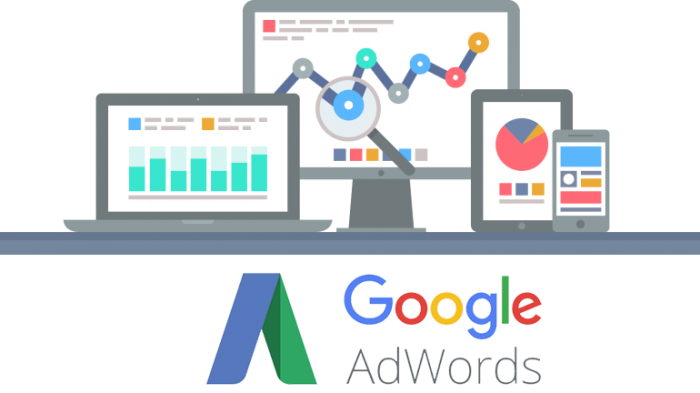
When looked at from another perspective, Google provides unmatched advertising opportunities to businesses of all types and sizes due to the big-size audience available there.
If you are looking to advertise your business on Google, Google Adwords emerges as the first choice. It is also known by the name of Google Ads. Among all the advertising mediums available today to marketers, Google Adwords is an effective way to get qualitative traffic to your website whenever people search for a relevant product or service on Google.
Know how to advertise on Google. Also learn the benefits of advertising on Google.
How do Google Ads work?
Google Ads is based on a pay-per-click (PPC) model. This simply means that marketers need to make a bid on a specific keyword to outperform other businesses and marketers focusing on the same keyword.
The bids made by you are called “optimum bids” which refer to the maximum amount you are ready to pay for an ad.
For instance, if you made an optimum bid of $5 and Google finds that your cost per click is $3, then you can get your ad placed! If Google finds that it’s more than $5, the ad won’t get placed.
A maximum daily budget can also be established for your advertisement. You’ll never spend more than a certain amount every day on that advertisement, which will help you determine the appropriate budget for your digital advertising campaign.
There are three bid options for marketers:
Cost Per Click (CPC)
refers to the fee paid each time a user clicks on an advertisement
Cost-per-mille(CPM)
represents the cost paid for every 1,000 ad impressions.
Cost-per-engagement(CPE)
the cost paid when a user takes a specific action on your ad, such as registering for a list or watching a video.
Google combines your bid amount with an assessment of your ad's quality, known as Quality Score, which is rated on a scale from 1 to 10, with 10 being the highest score. A higher Quality Score leads to a better ad rank and can result in lower costs for conversions.
It's important to note that your Quality Score and bid amount together determine your Ad Rank. Ad Rank dictates the position of your Google ad on the search results page (SERP).
When a user views your ad and clicks on it, the marketer or business owner incurs a small fee, which is why this model is known as pay-per-click (PPC).
PPC Packages
What does Google Ad Campaign Management Mean?
Google Ad Campaign Management involves more than merely setting up Google Ads. it encompasses the ongoing process of optimizing and fine-tuning your ad campaigns to achieve desired results. Effectively managing Google Ads requires a multi-faceted approach, including in-depth analysis of ad performance, experimentation with various keyword combinations, crafting compelling ad copy and designs, and making adjustments based on key metrics to assess their performance. All these components collaborate to create an efficient Google Ads campaign that can yield profitable outcomes for an extended period, possibly even years if the right strategies are employed.
Google Ads experts emphasize the significance of investing effort into Google Ads Management, as it tends to deliver favorable results in the long term.

Different Types Of Google Ads
Google offers various ad formats to align with different campaign objectives. Each ad type has its unique advantages, including cost-effectiveness, user-friendliness, message conveyance, and more. Below are some of the popular types of Google ads, along with common campaign types available on Google Search:
Search Network Campaigns
Search Network Campaigns are indeed the most prevalent type of Google search ads. These campaigns display text ads to users actively searching for specific keywords on Google's search results pages. This type of advertising is highly targeted, as it allows businesses to reach potential customers who are actively seeking products or services related to their keywords of choice.
Dynamic Search Ads
Dynamic Search Ads (DSAs) are search network campaigns that automatically generate ad headlines and landing pages based on a website's content, using Google's algorithm. They simplify ad creation and ensure relevancy to the site's content.
Shopping Campaigns
Shopping campaigns feature product listings ads (PLAs) displaying images, product details, and pricing information. These ads are visible in Google search results and on Google Shopping, making them ideal for e-commerce businesses.
Display Network Campaigns
Display Network campaigns showcase image and video ads across websites within Google's Display Network, allowing precise targeting based on demographics, interests, and user behavior.
Video Campaigns
Video campaigns display video ads on platforms like YouTube and Google partner sites, with the ability to target specific demographics, interests, and behavior for a highly tailored advertising approach.
App Campaigns
App campaigns are designed to reach users searching for apps on Google Play and other Google platforms. These campaigns can be used for promoting app installs, encouraging app engagement, or driving app conversions, offering a versatile approach to mobile app advertising.
Searching for Google Ads Solutions to Boost Your Business Marketing?
If you're considering running Google Ads, it's essential to understand the intricacies of a successful Google Ad Campaign. Managing Google Ads is a more complex process than it may appear at first glance. It entails a significant investment of time and effort, including campaign setup, performance assessment, experimenting with diverse keyword combinations, and thorough oversight of various elements. However, when these aspects are effectively orchestrated, they collaborate to yield the desired results for your marketing campaign.
To begin with, when configuring your Google Ads Campaign, it's crucial to establish email notifications. This practice ensures that you remain informed about all campaign activities.
During this setup, you can specify the specific actions for which you wish to receive notifications. Some marketers prefer alerts for only critical matters, while others opt for comprehensive coverage, receiving notifications for even minor ad-related events.
Frustrated by Underperforming Google Ads? Unleash Your Potential with our Innovative Google Ads Management Guide.

Our Approach to Google Ads Management
Effectively managing Google Ads is a critical step following their activation in Google AdWords. We adhere to a structured process, comprising several steps, to optimize Google Ads campaigns for optimal results.
Tracking Google Ad Performance
Vital to Google Ads campaign management is vigilant monitoring of your ads. This process helps identify the effectiveness of your strategies.
In general, five key factors merit consideration in Google Ads Management:
- Ad cost
- Ad clicks
- Impressions
- Click-through rate (CTR)
- Ad conversions
- Return on ad spend (ROAS)
- Average Cost-per-conversion (CPA)
Now, let's delve into a more detailed examination of each of these metrics.
Ad Cost
This metric represents the expenditure incurred by marketers in their Google Ads campaigns, technically known as "cost per click" (CPC).
Determining this cost is a complex task, as it is influenced by various factors, including the ad rank, quality score, and submitted bid. The bid signifies the maximum amount advertisers are willing to invest for a single click, while the ad quality score assesses the relevance of the ad, chosen keywords, and landing page. The ad rank, assigned by Google, ultimately determines the ad's placement.
Ad Clicks
At the core of any Google Ads campaign lies the fundamental metric: ad clicks. The primary goal of running Google Ads is to generate clicks. A prosperous ad campaign is one where the ad is consistently receiving clicks. If this isn't the case, it's necessary to reassess your ad campaign setup and associated components.
Impressions
Impressions denote the number of times your ad is displayed to visitors. The greater the number of impressions your ad garners, the higher the likelihood of receiving clicks. Increasing your ad campaign budget is a proven method to enhance ad impressions, providing your ad with greater visibility on Google. However, it's crucial to note that while budget plays a role, ad quality and relevance are equally significant.
Google's algorithm may not prioritize your ad if it deems the audience as irrelevant, resulting in limited impressions and underwhelming performance.
Click-Through Rate
The click-through rate (CTR) serves as a crucial metric for assessing an ad's relevance. It aids advertisers in determining whether their running ads are effectively resonating with the target audience. A Google ad with a high CTR indicates that the ad is not only gaining visibility but also receiving clicks, potentially leading to conversions.
If you've observed that your ad accumulates numerous impressions and clicks but struggles to convert, this suggests that the issue lies not in the ad copy but in the alignment of the products or services with the ad. CTR can be calculated using the following formula:
CTR = (Clicks / Impressions) x 100
While a CTR of around 5% is commonly seen, there is no fixed benchmark, as many advertisers have achieved successful results even with lower click-through rates.
Conversions
A conversion occurs when a visitor takes the intended action on your landing page or website, transitioning from the search engine results page to complete a specific goal
For instance, if you're running an ad for an online store and the objective is for users to view the ad, click it, and subsequently make a purchase from your landing page, the act of making that purchase would be considered a conversion.
Cost-per-conversion (CPA)
It represents the average cost incurred by the advertiser for each conversion resulting from the ad.
Return on ad spend (ROÄS)
ROAS is a vital metric for quantitatively evaluating the impact of advertising campaigns on an online retailer's profitability. Analyzing ROAS across all campaigns provides valuable insights that inform future spending, strategy, and overall marketing decisions when considered alongside customer lifetime value. By closely monitoring ROAS, advertisers can make informed choices regarding where to allocate their advertising budgets and enhance efficiency in their marketing efforts.
Understanding Your Audience
Targeting is a pivotal aspect of all digital marketing endeavors. To gain insight into the purchasing intentions of your audience, it's essential to begin with a well-defined buyer persona.
Consider the following questions: What are the desires of your ideal clients? What does their demographic profile look like? Where do they reside? What income bracket do they fall into? What are their interests and concerns? By taking these factors into account when selecting your ad targeting, you can better connect with your audience's mindset, increasing the likelihood of them clicking on your ad and making a purchase.
Review the following metrics that aid us in deciphering Google Ads targeting.
Affinity
This involves reaching your target audience through thorough research and display networks.
Demographics
Concentrating on the audience with regard to factors such as age, location, devices, and gender.
Custom intent
Selecting keywords closely related to the target audience, who share similar intent and interests.
In-market
Displaying ads to individuals with a track record of searching for products similar to what is being advertised.
Remarketing
Re-engaging individuals who have previously viewed your ad but did not complete a purchase, with the aim of encouraging them to convert.
A/B Testing of Ad Copies & Design
Following the refinement of your ad campaign's targeting, the next crucial step is to enhance your ad copy and design. This process may involve various elements, such as:
The Ad Offer
Headline
Description
The URL
Extensions
Consider testing these elements against alternatives if any of them appear to be diminishing the effectiveness of your advertisement. The key lesson here is to make only one adjustment at a time; this is the best way to pinpoint the issue.
For example, if you notice that you're receiving numerous impressions but not many clicks, you might want to experiment with modifying the ad's title, as it may not be compelling enough to entice clicks. Conversely, if you're getting plenty of clicks but few conversions, it's possible that your offer isn't sufficiently relevant.
Dynamic ads have become a popular choice among advertisers in such situations. They automatically extract content from your website to enhance the relevance of your ad's headline and description. This approach reduces the effort associated with crafting ad copy, making it advisable to give dynamic ads a try for creating customized ads.
Updating negative keywords
An important step is to identify and include negative keywords, which are keywords for which you don't want your ad to be displayed. Several reasons can prompt this strategy, with a significant one being to prevent Google from making decisions on your behalf. For instance, you can opt for negative keywords that encompass competitors, brands, and other terms unlikely to lead to conversions.
To integrate these keywords, navigate to the Google Ads campaign manager, select "Keywords," then "Negatives," and choose the keywords you wish to add to your ad group.
Landing Page Optimization
While Google ad campaigns primarily focus on Search Engine Results Pages (SERPs), it's crucial not to overlook the optimization of your landing page. In many instances, advertisers receive impressions and clicks on their ads, but they fail to convert. One major factor contributing to this issue is an unoptimized landing page. It's essential to address this aspect of Google ad management because, if Google detects it, your ad's position could be adversely affected due to decreased ad relevance.
When it comes to optimizing the landing page, it's imperative to consider all underlying elements, including the ad headline, page structure, button placement, calls to action (CTA), and calls to action. One proven method for achieving this is through A/B testing.
Key Elements for Creating an Effective Landing Page
- A compelling headline, directly related to your targeted keyword and ad copy, entices visitors to stay.
- Clear and concise ad copy that effectively communicates the value of your product or service.
- A user-friendly landing page form that reassures visitors and makes it easy for them to take action.
- An intuitive and visually appealing design that conveys professionalism, contributing to brand consistency.
- A seamless and persuasive call to action, supported by a clickable button for enhanced engagement.
Enhancing your landing pages can be a resource-intensive process, typically involving a graphic designer, developer, IT resources, and a hosting environment to execute it effectively. Given the potential bottlenecks in this process, many AdWords advertisers resort to directing PPC traffic to their homepage, which is counterproductive for conversion rate optimization.
If you notice that your ad lacks an adequate number of call-to-action (CTA) buttons on the landing page, consider creating a duplicate page and adding more CTAs to gauge the impact. The most efficient way to achieve this is by utilizing a landing page building and optimization tool like Covert.com or Unbounce. For A/B testing, Convert is a valuable resource, as it offers practical guidance on how to enhance your landing page's performance.
Consider Transitioning to Automated Bidding
When it comes to bidding in Google Ads, you have two options: manual and automated bidding.
Automated bidding is a Google Ads bidding strategy designed to optimize results based on the underlying campaign objectives. In automated bidding, Google itself determines the bid amount by evaluating the likelihood of a click or conversion on your ad. This assessment takes into account various factors, including the user's device, specific timing, operating system, location, and demographics.
Google relies on portfolio bid methods for all its automated bid strategies, which are essentially goal-driven strategies that encompass multiple campaigns, ad groups, and keywords. As a result, marketers have the flexibility to apply their preferred approach to individual campaigns, ad groups, and keywords. Some of these strategies are available as general tactics, applicable to single campaigns as well.
There are essentially seven types of automated bidding strategies.
1. Increase ad clicks
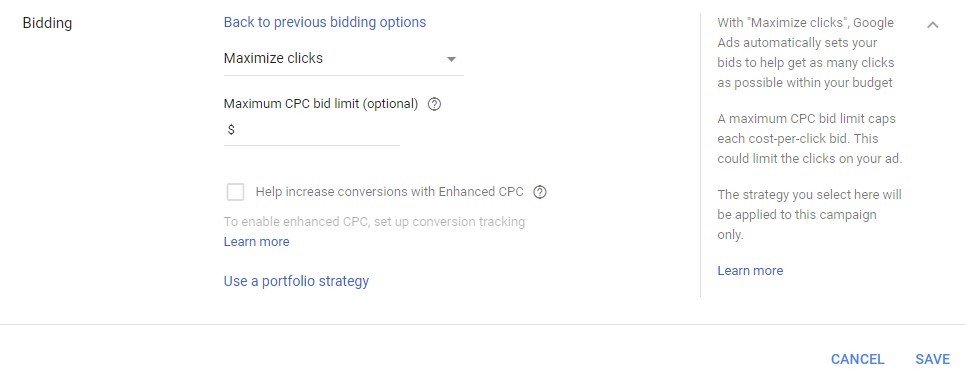
Source: - support.google.com
The "Maximize Clicks" approach is aimed at increasing website traffic. This strategy automatically adjusts bids to help you obtain the maximum number of clicks within your budget. It is available as a portfolio bid strategy that spans multiple campaigns, ad groups, and keywords, or as a traditional strategy within a single campaign
2. Target outranking share
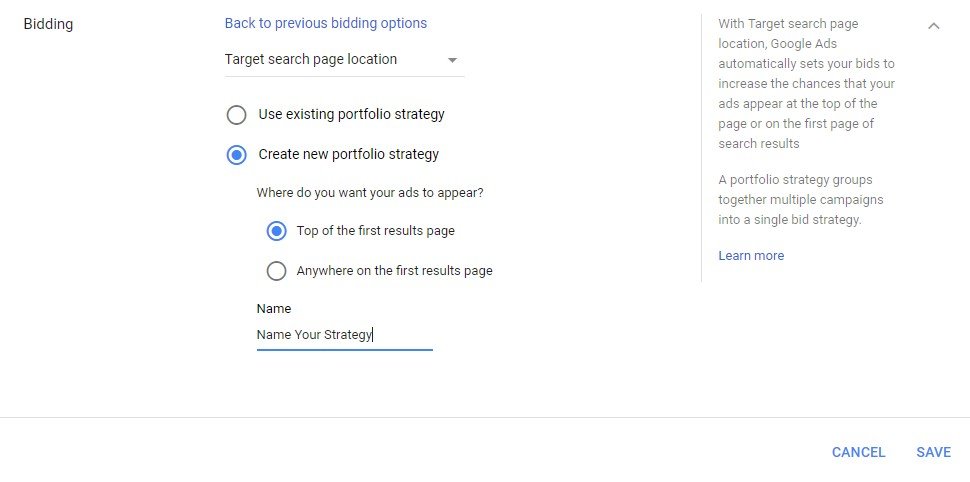
Source: - support.google.com
With "Target Outranking Share," you have the ability to choose the domain of another advertiser that you aim to surpass in ad position and specify how often you'd like to achieve this goal. Google will then automatically adjust your search bids to help you attain this objective. Target Outranking Share is exclusively available as a portfolio bid strategy.
3. Target search page location
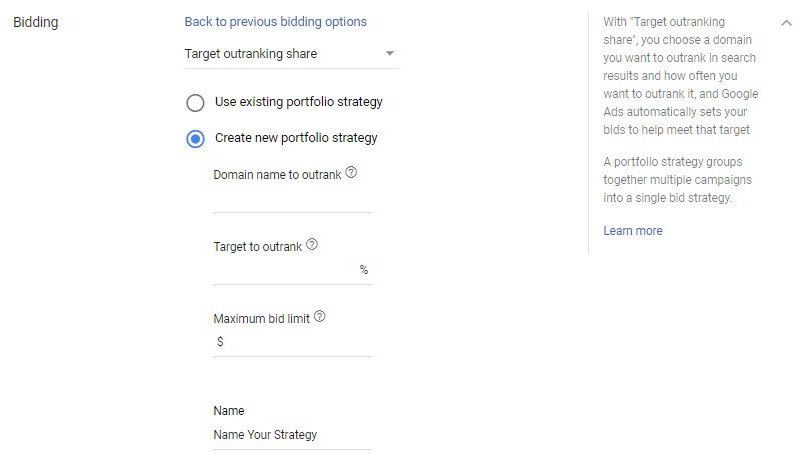
Source: - support.google.com
The "Target Search Page Location" strategy is designed to increase the chances of your ad appearing on the first page of a Google search or in one of the top ad positions. This strategy automatically adjusts your bids to achieve this goal. It's exclusively available as a portfolio bid strategy on the Search Network.
4. Target cost-per-acquisition (CPA)

Source: - support.google.com
"Target CPA" provides you with greater control over your automatic bidding. Google uses this strategy to automatically set Search or Display bids, allowing you to maximize the number of conversions at your specified cost-per-acquisition (CPA). Keep in mind that some conversions may cost more or less than your set CPA.
5. Optimized cost-per-click (CPC)

Source: - support.google.com
Enhanced Cost-Per-Click (ECPC) is designed to help you boost conversions while attempting to maintain a consistent cost per conversion. When using ECPC, Google automatically adjusts your manual bids. It's available as an optional feature when employing Manual CPC bidding or as part of a portfolio bid strategy.
6. Maximize return on ad spend (ROAS)

Source: - support.google.com
With "Target ROAS," your bids are automatically optimized to maximize conversion value at the specified Return on Ad Spend (ROAS), which is the average value you receive for every dollar spent on ads. Keep in mind that some conversions may result in higher or lower returns than initially anticipated. Both portfolio bid strategies and traditional campaign bid strategies can make use of the Target ROAS approach.
7. Optimize conversions

Source: - support.google.com
The "Maximize Conversions" strategy automatically adjusts bids to maximize conversions for your campaigns while staying within your budget. Google optimizes for a higher volume of conversions with this approach. Maximize Conversions is a standard campaign strategy and is not available as a portfolio bid strategy.
On the other hand, if you opt for manual bidding, you'll be responsible for managing your keyword bids on the Google Ads platform. One significant advantage of manual bidding is that it offers advertisers more control over how they set up their ads.
In general, advertisers and businesses rely on experience, intuition, and the analysis of historical keyword performance data to make their bidding decisions. This process is intricate and requires a high degree of patience, time, and expertise in Pay-Per-Click (PPC) to ensure a favorable return on investment (ROI).
8. Avoid Common Google Ads Mistakes
Lastly, it's essential to steer clear of common Google Ads mistakes that can hinder your ad's performance. Some of these mistakes include:
- Selecting an Inappropriate Keyword Match
Keyword matching options, such as broad match, exact match, and phrase match, are familiar concepts in Google Ads management. Choosing the wrong keyword match type can make it challenging for your ad to effectively target your intended audience.
For example, a broad match will display your ad when a user searches for a term similar to your target phrase. This can be effective when you're in the early stages of exploring and gathering data. If you have limited knowledge about your audience, using "exact match" wouldn't be advisable because you lack the statistical data to support it.
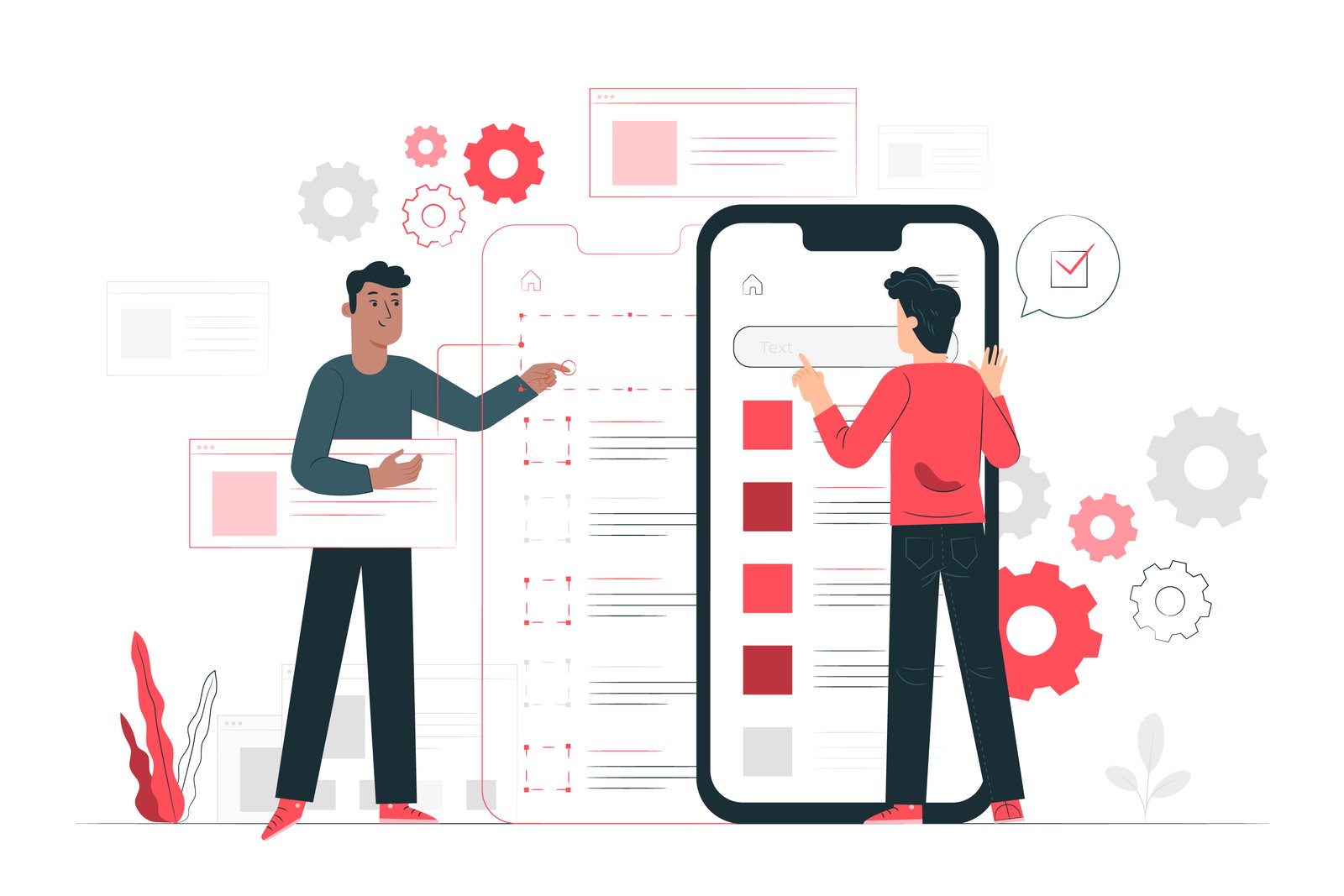
Unprofessional Ad Copy
Crafting professional and compelling ad copy is undeniably the most crucial element when establishing your Google ad campaign. Mastering the art of excellent copywriting is key to achieving conversions, as long as your ad aligns with your audience and all other campaign components are in order. Familiarize yourself with the maximum character limits for headlines and descriptions and make the most of this valuable space.
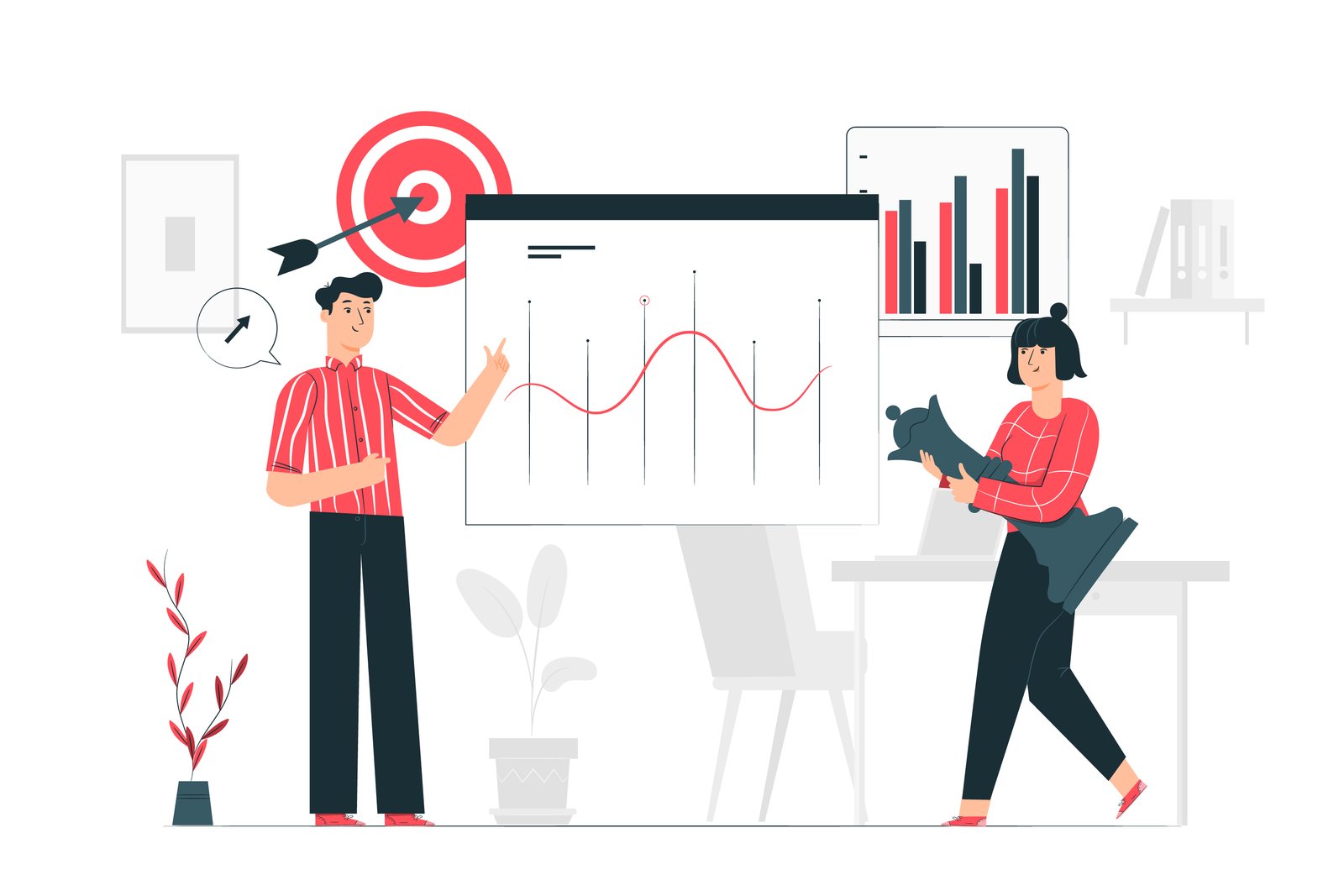
Improper clear margins
When determining your bid amount for Google Ads, the decision on how to allocate your available budget is entirely in your hands. If you feel uncertain about how to proceed, it's crucial to remember not to overspend on ads. It's essential to make adjustments as needed to ensure you achieve the best possible returns. Proper budget management is a key factor in the success of your advertising campaign.
Advantages of Choosing UV Soft Solution for Google Ads Management Services
UV Soft Solution is a prominent digital marketing agency offering Google Ads management services. With a wealth of experience in handling Google Ads, UV Soft Solution possesses the expertise and insights required to optimize your Google Ads campaigns for maximum results..
Below are some of the advantages of enlisting UV Soft Solution for Google Ads management services:
#1 Skilled and Certified Team
UV Soft Solutions boasts a team of seasoned and certified Google Ads professionals who are well-equipped to enhance the performance of your campaigns.
#2 Comprehensive Range of Services
UV Soft Solutions provides an all-encompassing array of Google Ads management services, covering campaign planning and setup, continual optimization, and comprehensive reporting.
#3 Demonstrated Success
UV Soft Solutions has a well-established history of achieving success in the management of Google Ads campaigns across various business sectors. We possess the expertise to assist you in crafting a highly effective campaign that reaches your intended audience and enables you to attain your marketing objectives.
#4 Adaptable Pricing
UV Soft Solutions provides flexible pricing choices that are tailored to suit your budget and requirements.
#5 Ongoing Monitoring and Fine-Tuning
UV Soft Solutions offers assistance in monitoring your campaign results and making essential adjustments to guarantee that you are maximizing the returns on your investment.
If you're in search of a Google Ads management agency that can assist you in optimizing your campaigns for the best results, don't hesitate to get in touch with UV Soft Solutions today.
Determining Your Monthly Google Ads Services Budget
The actual amount to invest in Google Ads services varies depending on several factors. Generally, advertisers may spend as little as 10,000 INR or go up to more than 2,00,000 INR. The specific budget is influenced by your campaign objectives, target demographics, search volume, and industry sector.
The budget required for Google Ads to achieve your objectives is also vital, particularly if your goal is to generate a significant number of leads beyond your current results.
The next step in assessing the budget for Google Ads is understanding the cost of acquiring visitors. We base our estimate on the cost per click (CPC) for keywords available in the Google Ads Keyword Planner. A straightforward search indicates that the average CPC is likely to be around $5 for relevant searches. For those advertising on the Google Search Network, PPC is a cost-effective and viable option, with advertisers potentially spending $1 to $2 per click.
Hiring the Best Google Ads Management Company in India
Selecting the right Google Ads campaign management company in India involves considering several factors to ensure you get the best outcomes. Here's a step-by-step guide on how to choose the best Google Ads agency:
- Determine Your Campaign Objectives :– Start by defining your primary campaign objectives. Some businesses aim to drive more website traffic, while others seek to expand their customer base, generate more leads, increase sales, or boost brand awareness. It's essential that the digital marketing agency understands your specific needs to deliver the best results.
- Set a Budget :– Decide on the budget you're willing to allocate to your ad campaign. Having a clear budget in mind will help you select an agency that can maximize your budget effectively. Google Ads management allows for campaign pausing and resuming based on the agency's analysis, providing flexibility.
- Choose an Experienced Company :– Experience is invaluable in any industry. Understanding how Google Ads campaign algorithms work requires practice and expertise. A company with a history of managing various advertising campaigns is likely more knowledgeable than a new agency. They possess the know-how to identify issues and enhance ad performance for better results.
- Check Their Certification :– Since you're investing in paid advertising through PPC marketing, it's crucial to ensure that your PPC management company is certified. While a chosen agency may claim to have knowledge and expertise, Google Ads certification is a significant advantage. Certification demonstrates a commitment to PPC marketing, as it requires a professional or expert to pass an exam to qualify.
Key Considerations When Hiring a Google Ads Management Company in India
Here are some critical factors to keep in mind when hiring the best Google Ads campaign management company:

Expertise is Key
Prioritize agencies that have a long history of managing Google Ads campaigns for their clients. This longevity signifies the agency's extensive experience with various types of Google Ads and its ability to adapt to the field's evolving landscape. Such agencies are more likely to possess a team of highly skilled and seasoned ad campaign specialists who can effectively manage your campaigns.

Customer Support is Crucial
Effective customer support is essential. Regardless of how excellent your agency may be, there will be times when you need their assistance with specific issues or to refocus on other aspects of your business operations. Therefore, it's important to partner with an agency that can provide you with customer support every day.

Pricing Matters
Pricing is undeniably a critical consideration when selecting a Google Ads campaign management agency. Google Ads charges typically consist of two components: the agency management fee and the budget allocated to the Google Ads account. Understanding these costs is essential to effectively manage your advertising expenses.

Assess Their Reputation
Assess the agency's reputation by reviewing feedback from former and current clients. Scrutinize the company's case studies and peruse customer reviews and testimonials. This will provide insights into the agency's performance, trustworthiness, and ability to collaborate effectively.

Analyze Client Choices
Evaluate the range of packages offered by different Google Ads agencies. Ensure that the Google Ads agency you select has packages that are both cost-effective and aligned with your specific needs. A thorough understanding of each package is crucial for maximizing the value of your investment.
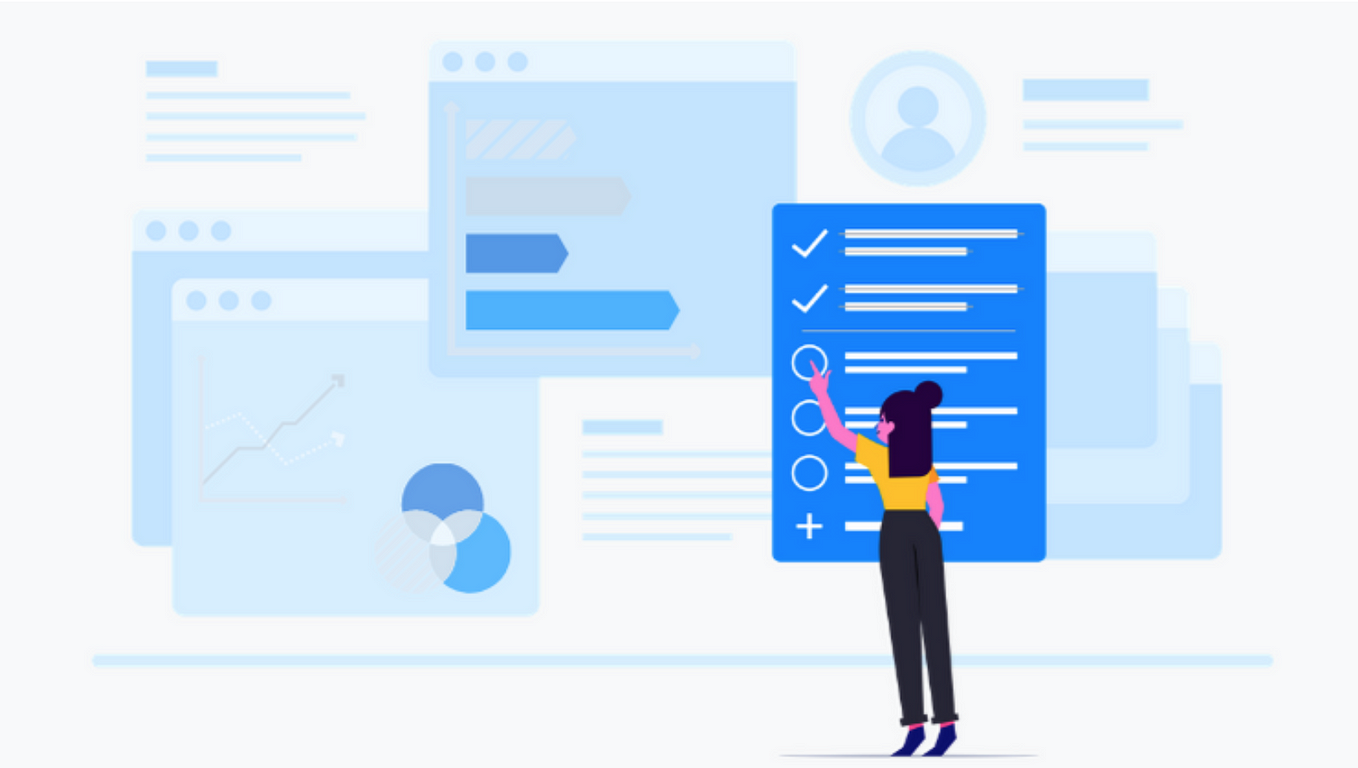
Consider Reporting Capabilities
Analyze the agency's reporting capabilities. A reliable digital advertising agency should utilize tools like Google Analytics and Google Data Studio to provide performance reports that meet your team's requirements. They should be able to effectively explain the significance of their findings and demonstrate the value they provide.
Consider that, beyond raw data, the critical aspect is the interpretation and actionable insights derived by your Google AdWords agency from the data to enhance your strategy. Your PPC partner should not only furnish performance statistics but also identify opportunities and implications for your ongoing strategy.
The capacity to track conversions from Google Ads within your account holds significant sway over its success. It's challenging to refine your approach when you're uncertain about what's effective and what's not. Utilizing conversion tracking, you can discern the most potent advertisements.
Armed with this information, you can make adjustments to your campaigns, such as refining keywords, optimizing budget allocation, fine-tuning bidding strategies, and applying the successful tactics of high-performing ads to enhance the performance of those that need improvement.
Tracking Conversion in Google Ads
To effectively monitor conversions in Google Ads, you must go through a process that involves defining your conversions, setting up the necessary tracking tag, and selecting an attribution model. However, this process can be more complex than it seems, and we'll discuss the detailed procedures in this blog entry. To provide a clear understanding, let's first define each of these terms and their significance for your Google Ads account.
Conversions refer to significant actions that users take after interacting with your advertisement. The definition of what constitutes a conversion can vary from one company to another. For example, it could encompass activities such as engaging in live chat, calling your business, clicking on specific links, watching videos, submitting forms, and more. These diverse actions are all classified as conversion activities.
Conversion Tracking
the practice of systematically monitoring and recording all completed conversion activities that are associated with your account. It allows you to determine which advertisements are responsible for generating these conversions, providing valuable insights into the performance of your ad campaigns.
Attribution modeling
It is a critical component of your conversion tracking setup that influences how conversions are measured. An attribution model defines the rules for assigning credit to one or more ads when a user interacts with multiple ads before completing a conversion action. It helps determine which ad or ads should receive credit for driving the conversion when multiple ads have played a role in the user's journey. This is important for understanding the impact of various touchpoints in your advertising campaigns on your overall conversion performance
Google Tag
It is a code snippet that you integrate into your website, acting as an intermediary between your website and your Google Ads account. It plays a crucial role in enabling your website to effectively communicate completed actions back to your Google Ads account for tracking and analysis. This code snippet facilitates the accurate measurement of conversions and other user interactions on your website, helping you assess the performance of your Google Ads campaigns.
Conversion Value
It is an option within various conversion activities that allows you to assign a specific value to a particular action. This assigned value can have an impact on your account's bidding strategies, such as maximizing the conversion value. It helps Google Ads determine the importance and significance of different conversion actions, enabling you to make informed decisions about budget allocation and bid adjustments.
Portfolio of Our Google Ads Marketing Services
Accounting Outsource Hub an Accounting company embarked on a project with the objective of increasing sign-ups. To achieve this, we launched a Google Search campaign focused on driving new sign-ups.
| Campaign Performance | |
|---|---|
| CTR | 11.23% |
| Avg CPC | £0.94 |
| Conversions | 40 |
| Conversion Rate | 18.52% |
| Cost/ conversion | £5.07 |
"This campaign was specifically targeted in the United States."
A Photography Company Based in Australia Google Ads
| Campaign Performance | |
|---|---|
| CTR | 11.23% |
| Avg CPC | £0.94 |
| Conversions | 40 |
| Conversion Rate | 18.52% |
| Cost/ conversion | £5.07 |
The phone calls were generated through a call extension, although our campaign's primary goal was to increase the number of leads acquired via a website form.
A Pharma based company in Chandiagarh, the primary goal of this project was to increase the number of phone calls from potential clients looking to book appointments. To achieve this objective, a call ads campaign was launched through Google Ads.
| Campaign Performance | |
|---|---|
| CTR | 2.18% ( Because this is a call campaign so this CTR is good) |
| Avg CPC | 186.63 INR |
| Conversions | 10 |
| Conversion Rate | 31.25% |
| Cost/ conversion | 597.22rs |
We were running this campaign in Chandigarh.
What Google ads experts do to enhance Google ads campaigns?
In simpler terms, the primary duty of a Google ads manager is to oversee all aspects of a Google ads campaign. Nevertheless, this role entails various tasks that need to be executed with precision to achieve superior results.
Let’s look at these tasks below:
- Creating Well-Defined and Effective Google Ad Campaign Strategies
- Conceiving, Launching, and Managing Various Google Ad Campaign Types
- Conducting Keyword Research to Compile a Keyword List for Bidding
- Managing Budgets and Bidding Approaches for Optimal ROI
- Executing A/B Testing by Crafting Multiple Ad Copies With Differing Headlines and Descriptions:
- Managing Bids and Formulating Campaign Strategies
- Creating and Enhancing Appealing and Relevant Landing Pages for Google Ads
- Monitoring Key Performance Indicators (KPIs) for Performance Assessment
- Strategizing Audience Targeting
- Producing Timely and Accurate Reports for Ad Management and Insights
- Evaluating and Supervising Ongoing Ad Campaigns and Providing Optimization and Revitalization Recommendations
- Preparing Comprehensive Analyses and Reports for Ad Campaigns
- Analyzing Current Marketing Trends and Adjusting Ad Campaigns Accordingly
- Offering Strategies for Preventing Fraud
- Providing Recommendations to Enhance Campaign Creativity
Would you like to explore further information about our Google Ads management services in India?
Are you keen on discovering additional details about our Google Ads management services? Our team comprises certified Google Ads experts who can assist you in crafting and overseeing your campaign, allowing you to concentrate on your business objectives. We provide a complimentary consultation to delve into your requirements and goals. Subsequently, we create a tailored Google Ads management strategy to aid you in reaching those objectives. Get in touch with us today for more information!
Frequently asked questions
The goal of SEO, which is a longer-term strategy, is to increase your organic search and referral traffic by properly setting up your website and online presence. Although you don’t pay for this traffic, doing it correctly will cost you time and money.
Google AdWords is a technique to get targeted traffic to your website is using Google AdWords. It is easy to set up and generates visitors much more quickly than SEO (generally). Both are continuing expenditures, but you only have to pay for AdWords clicks when customers are eager to buy your products or services.
To enhance conversions, it's important to optimize your landing page to align with the advertising that directed visitors there. Additionally, if needed, optimize your website to ensure fast loading times. Furthermore, utilizing Google's conversion tracking is an excellent method to enhance conversion rates effectively.
Google Ads offers several advantages that can drive the performance of your online advertising campaigns. Here are some key benefits of using Google Ads:
- High Search Volume
- Global and Local Exposure
- Broad Customer Base
- Budget Flexibility
- User-Friendly
- Measurable Results
Write Us Any Message
Email Address
info@uvsoftsolutions.com
uvsoftsolutions01@gmail.com
Location India
SCO 86-C 2nd Floor, City Heart, Kharar, Sahibzada Ajit Singh Nagar, Punjab 140301
Phone No:(+91) 99887 97174
Location Australia
73 Churchill Road, Prospect, Adelaide, SA 5082, Australia
Phone No:(+61) 4 6983 0301
